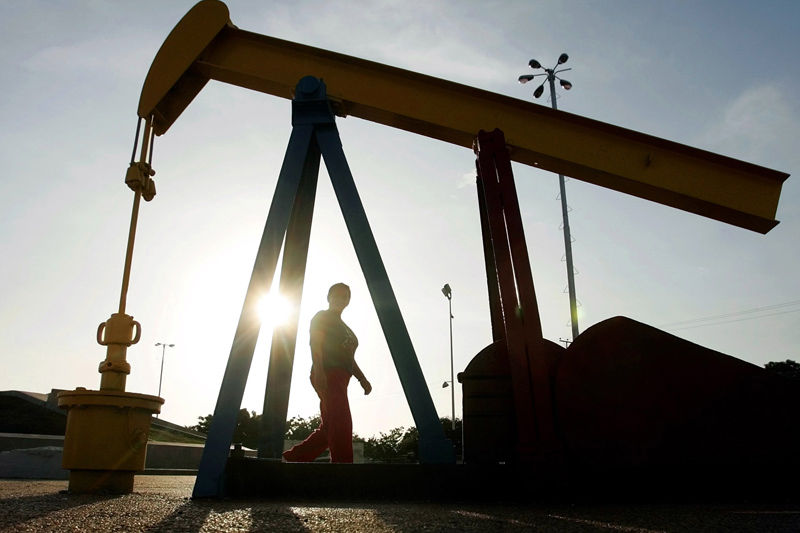Investing.com - Crude oil futures slipped lower Monday, striking an eight-month low despite the U.S. dollar moving lower against its major counterparts, as ongoing concerns over weakening global growth prospects continued to pressure oil lower
On the New York Mercantile Exchange, light sweet crude futures for delivery in July traded at USD83.17 a barrel during U.S. afternoon trade, falling 0.05%.
It earlier fell by as much as 2.1% to trade at USD81.22 a barrel, the lowest since October 6, 2011.
Oil futures found support as the dollar index gave up early gains and entered negative territory, as concerns over the situation in the euro zone eased slightly and amid growing hopes for policy action from global central banks.
The euro found support after Portugal’s Finance Minister Vitor Gaspar announced that the country's EUR78 billion bailout program was on track. Gaspar also said Lisbon is planning a EUR6.65 billion liquidity injection to shore up the country’s fragile banking system.
Meanwhile, official data showed that producer price inflation in the euro zone was flat in April, which could give the European Central Bank leeway to cut rates ahead of its policy meeting this week.
Market sentiment found further support amid speculation over coordinated liquidity-boosting measures by world central banks.
Traders are closely watching several monetary policy meetings due this week, including the European Central Bank on Wednesday and Bank of England on Thursday, for clues on their responses to weakening global growth.
Federal Reserve Chairman Ben Bernanke on Thursday will testify before a congressional committee about the state of the U.S. economy.
Energy prices came under heavy selling pressure during the Asian trading session, as markets were spooked after the Department of Labor said Friday that the U.S. economy added just 69,000 jobs in May, the smallest increase in a year and far below expectations for a gain of 150,000.
The unemployment rate unexpectedly ticked up to 8.2% from 8.1%, the first increase in 11 months.
Meanwhile, downbeat manufacturing data from China and Europe hurt prospects for global oil demand, further weighing on prices.
A deeper slowdown in China, the world’s second biggest economy, would impair a global expansion that is already faltering because of the implementation of harsh austerity measures in Europe.
Oil futures have been on a rapid decline since the uncertain outcome of the May 6 elections in Greece, which threw the future of the country’s international bailout deal into doubt and fuelled fears over a possible Greek exit from the euro zone.
NYMEX oil prices have fallen more than 22% in the past five weeks, the largest five-week loss since the week to January 18, 2009. Prices are down almost 26% since hitting a March 1 intraday peak of USD110.53 a barrel.
Elsewhere, on the ICE Futures Exchange, Brent oil futures for July delivery dipped 0.3% to trade at 98.14 a barrel, with the spread between the Brent and crude contracts standing at USD14.67.
On the New York Mercantile Exchange, light sweet crude futures for delivery in July traded at USD83.17 a barrel during U.S. afternoon trade, falling 0.05%.
It earlier fell by as much as 2.1% to trade at USD81.22 a barrel, the lowest since October 6, 2011.
Oil futures found support as the dollar index gave up early gains and entered negative territory, as concerns over the situation in the euro zone eased slightly and amid growing hopes for policy action from global central banks.
The euro found support after Portugal’s Finance Minister Vitor Gaspar announced that the country's EUR78 billion bailout program was on track. Gaspar also said Lisbon is planning a EUR6.65 billion liquidity injection to shore up the country’s fragile banking system.
Meanwhile, official data showed that producer price inflation in the euro zone was flat in April, which could give the European Central Bank leeway to cut rates ahead of its policy meeting this week.
Market sentiment found further support amid speculation over coordinated liquidity-boosting measures by world central banks.
Traders are closely watching several monetary policy meetings due this week, including the European Central Bank on Wednesday and Bank of England on Thursday, for clues on their responses to weakening global growth.
Federal Reserve Chairman Ben Bernanke on Thursday will testify before a congressional committee about the state of the U.S. economy.
Energy prices came under heavy selling pressure during the Asian trading session, as markets were spooked after the Department of Labor said Friday that the U.S. economy added just 69,000 jobs in May, the smallest increase in a year and far below expectations for a gain of 150,000.
The unemployment rate unexpectedly ticked up to 8.2% from 8.1%, the first increase in 11 months.
Meanwhile, downbeat manufacturing data from China and Europe hurt prospects for global oil demand, further weighing on prices.
A deeper slowdown in China, the world’s second biggest economy, would impair a global expansion that is already faltering because of the implementation of harsh austerity measures in Europe.
Oil futures have been on a rapid decline since the uncertain outcome of the May 6 elections in Greece, which threw the future of the country’s international bailout deal into doubt and fuelled fears over a possible Greek exit from the euro zone.
NYMEX oil prices have fallen more than 22% in the past five weeks, the largest five-week loss since the week to January 18, 2009. Prices are down almost 26% since hitting a March 1 intraday peak of USD110.53 a barrel.
Elsewhere, on the ICE Futures Exchange, Brent oil futures for July delivery dipped 0.3% to trade at 98.14 a barrel, with the spread between the Brent and crude contracts standing at USD14.67.
